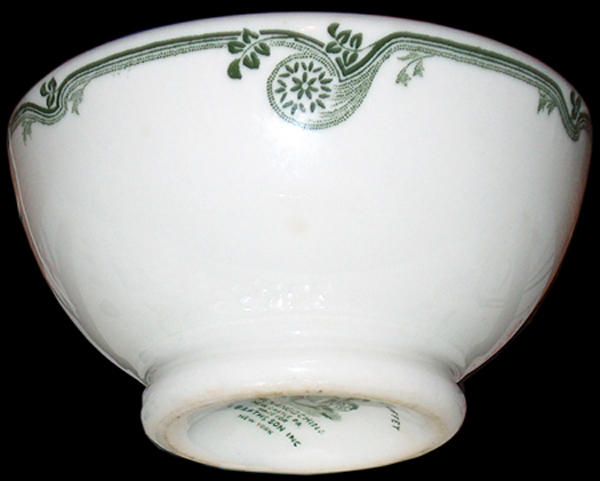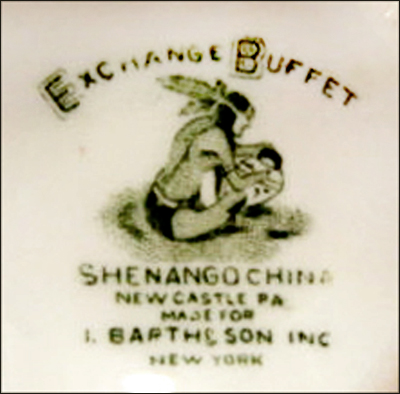Manufacturers: Shenango China, Jackson China
User: Exchange Buffet
Pattern name: Print #131 (Jackson)
Distributor: L. Barth & Son Inc. (Shenango)
Distributor: Duparquet (Jackson)
Date of Shenango footed bowl: 1912-1925
Date of Jackson plate: circa 1930s-1940s
Notes: Based in part on info taken from "Building a Six-Million-Dollar Business on Trust," by James True – on Google Books – the Exchange Buffet was a restaurant chain in New York City with some 35 locations and at least 42 cigar stands. Its restaurants were unique in several ways.
Although they staged a traditional cafeteria line, they also offered the option of ordering from a menu and customers were responsible for tallying their own bills – on the honor system. In his article, True noted that "the company considers all customers to be absolutely honest" and said, "This system has caused an invaluable amount of favorable comment and is undoubtedly the chief reason" for the chain's success.
In addition, True wrote about a 1913-14 advertising campaign launched by the Exchange Buffet that quoted Henry DeJongh, the company's president, as saying: "We are attempting to sell the men of New York on our restaurants, and convince them that every Exchange Buffet is 'A Man's Place.'" That misogynistic approach translated to the restaurant's menus that also advertised "A Man's Place."
The first Exchange Buffet (located at 7 New Street) started on Sept. 4, 1885 and was built opposite the New York Stock Exchange – the source of its name and also the source of its first patrons. And rather than being a new advertising ploy as True's article would suggest, the first mention of the restaurant in the Brooklyn Daily Eagle heralded that it "opened its doors to men-only customers."
By Oct. 13, 1922, the Exchange Buffet Company was being traded on the floor of the stock exchange, according to a New York Times article. It had been incorporated at that point for nine years.
The Exchange Buffet Corporation, as its name had evolved, filed for bankruptcy on Nov. 8, 1963, again according to the Times. "At one time the cafeterias were regarded as a symbol of man's fundamental honesty. But, a spokesman for the corporation said yesterday that the policy of trusting customers probably had contributed to the concern's financial troubles."
Numerous sources cited the chain's nickname: E & B, for "Eat 'em and Beat 'em," referring to the fast-food nature of the restaurants that allowed the customers to "eat and beat it" out of there.
The green-on-white pattern without topmark features a border formed of dark green lines and closely spaced dots interspersed with a paisley swirl of leaves, flowers and dots, all in dark green.
For related info:
Exchange Buffet by Shenango China
Exchange Buffet 3 by Shenango China and McNicol China
Contributor:
Plate photos: Attorney Anthony L. Draper






